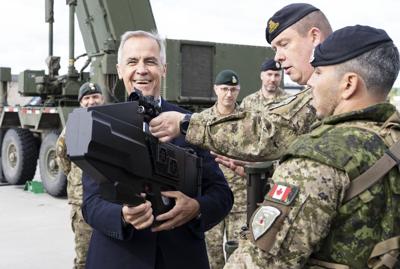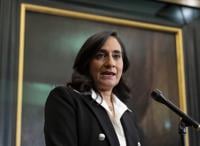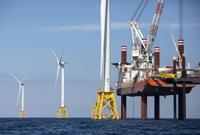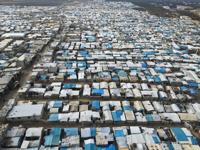OTTAWA - The federal government unveiled plans Tuesday to shell out $73 billion for national defence by the end of the decade — a staggering sum as Canada positions itself to meet aggressive NATO spending commitments.
The defence spending plan — which is light on specifics but presents hefty dollar figures — also hints at what's in the government's promised Defence Industrial Strategy and even teases a new "sovereign space-launch capability."
Finance Minister François-Philippe Champagne's first budget touts a towering topline figure of $81.8 billion on a cash basis over five years to build up the şĂÉ«tv Armed Forces.
That amount includes $9 billion in spending Prime Minister Mark Carney already announced in June so that Canada can finally meet its NATO commitment of spending the equivalent of 2 per cent on GDP this year.
Christyn Cianfarani, president of the şĂÉ«tv Association of Defence and Security Industries, said one look at the document's cover photo — of an icebreaker — says everything about where spending is headed under the new government.
"It basically says, defence is back. For too long, it's been under-funded, under-leveraged and this is the kind of budget that's going to change that," Cianfarani said.
David Perry, president of the şĂÉ«tv Global Affairs Institute, called the budget's defence boost a "really significant injection of funding" — possibly the most since the Korean War.
But a lack of specifics in the budget document invites questions about where the government intends to direct all the money.
"It's just kind of a curious lack of direction of what the şĂÉ«tv military will look like by 2030 as a result of big injections of funding from (former prime minister) Justin Trudeau and now from Mark Carney," said Perry.
Cianfarani said the industry will be watching for signals to follow from the fiscal plan.
The 2025 budget claims that Canada is already meeting a new, 1.5 per cent commitment under NATO — part of a much larger 5 per cent target, which Canada says it will meet by 2035.
That 1.5 per cent includes things that are defence-adjacent — such as spending by any level of government on emergency preparedness — while the remaining 3.5 per cent must be spent on core defence needs.
"The government expects that currently planned spending by federal, provincial, territorial and municipal governments will meet this 1.5 per cent commitment," the document asserts, without disclosing the government's internal calculations.
"The budget will allow us to meet our target," Champagne told a press conference in Ottawa on Tuesday. "In the 1.5 per cent … I think for Canada, this is going to be a way for us to build infrastructure in the North that northern communities will welcome."
"We have a deficit of infrastructure in a number of places, in the North in particular, when you look at how you protect Canada," he added.
Champagne also invited "every company in the country" to produce a "defence strategy" of their own, given the drive by governments around the world to spend more on defence.
"You do one thing, but at the same time you can pivot and do something else and I think we need to make sure that our defence investments serve first and foremost şĂÉ«tvs and that's what we're going to do," he said.
The Finance Department did not make available any internal calculations showing how the country's new spending stacks up over time under the NATO accounting framework.
The budget lays out $30 billion on defence-related capital spending alone, and promotes this as the "largest defence investment in decades." But it does not cite the last year Canada spent a comparable amount, nor does it flesh out the accounting.
The government of former prime minister Justin Trudeau only earmarked $7.9 billion for şĂÉ«tv Defence overall across a five-year period in its last major defence policy update, "Our North, Strong and Free." It also projected larger defence budgets over the coming decades.
Budget 2025 sets aside $17.9 billion over five years to expand the military's range of capabilities.
The fiscal document says that includes funding for "logistics utility, light utility and armoured vehicles, counter-drone and long-range precision strike capabilities, and domestic ammunition production, among other investments."
The spending plan doesn't break down any of these items, which don't include an expected multi-billion dollar procurement project to replace Canada's four rapidly aging Victoria class submarines.
The budget sets out $20.4 billion over 5 years for military recruitment and retention, an envelope that includes pay hikes and military health care supports and $19 billion to maintain existing capabilities and infrastructure.
Auditor General Karen Hogan warned just last month a large chunk of Canada's aging military infrastructure needs significant repairs. She also warned recruitment efforts have fallen short by thousands of needed service members.
Ottawa is bookmarking $6.6 billion for the forthcoming Defence Industrial Strategy, expected in the coming weeks, which will set out how the government plans to grow the country's domestic defence industry.
The budget says şĂÉ«tv Defence will establish a "sovereign space launch capability," a project that gets $182.6 million over three years; the budget offers no details.
A senior government official speaking on background said Canada relies on other countries to launch sensitive equipment like satellites — and not all of the available launch platforms are in friendly countries.
The budget also says Canada will set up a new research agency to be called BOREALIS with $68.2 million in funding over three years.
The Business Development Bank of Canada will get a billion dollars so it can give out loans, venture capital and advice to small and medium sized defence-related businesses.
Hundreds of millions of dollars are going to quantum technology and to critical minerals development — minerals which are key to many defence sector supply chains.
The government's new Defence Investment Agency — a special agency within Public Services and Procurement Canada tasked with speeding up purchases of military hardware — will get $30.8 million over four years.
It remains unclear how many people will staff this new office.
The budget earmarks $6.2 billion for "defence partnerships," which will include military aid for Ukraine.
This report by şĂÉ«tvwas first published Nov. 4, 2025.















































